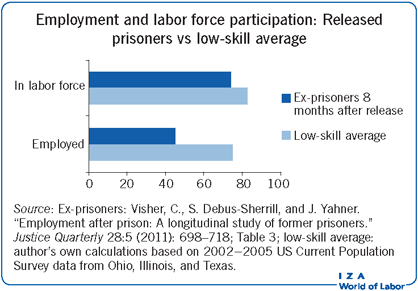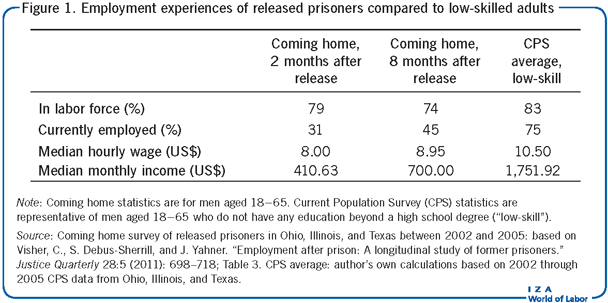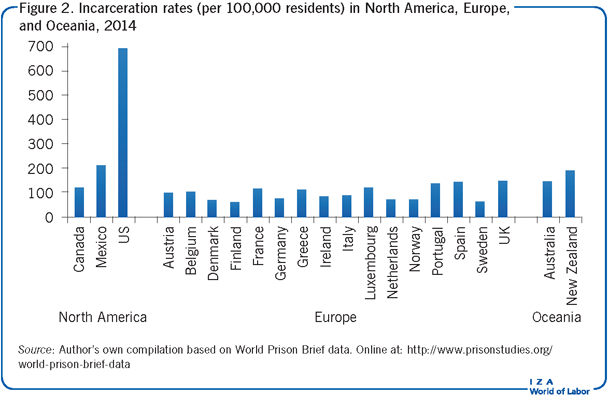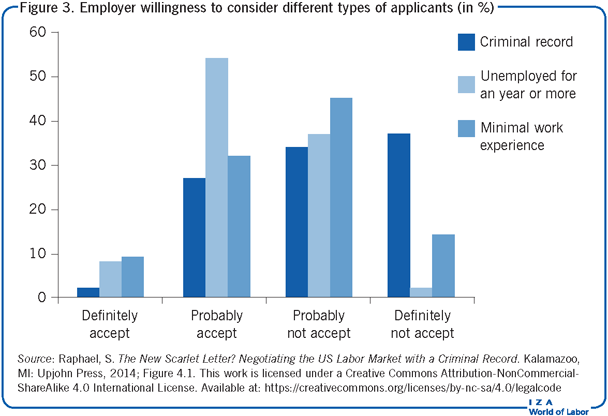Elevator pitch
The majority of individuals released from prison face limited employment opportunities and do not successfully reintegrate into society. The inability to find stable work is often cited as a key determinant of failed re-entry (or “recidivism”). However, empirical evidence that demonstrates a causal impact of job opportunities on recidivism is sparse. In fact, several randomized evaluations of employment-focused programs find increases in employment but little impact on recidivism. Recent evidence points to wages and job quality as important determinants of recidivism among former prisoners.

Key findings
Pros
Improvements in aggregate labor market conditions are associated with decreases in aggregate crime rates.
Recent evidence suggests that increases in wages for low-skilled workers and opportunities in sectors that pay higher wages to low-skilled workers can reduce recidivism among individuals recently released from prison.
Providing employers with information on offender rehabilitation and relief from potential liability can expand employment opportunities for ex-offenders.
Cons
Released prisoners face substantial obstacles such as substance abuse, mental health disorders, and social and family problems that dwarf any potential impact of employment on recidivism.
Several randomized evaluations of employment-focused re-entry programs report increases in post-prison employment rates that are not associated with large changes in recidivism.
Employment opportunities for released prisoners are scarce due to low levels of education and limited work experience as well as an aversion among employers to hire them.
Author's main message
Individuals who face limited job opportunities are more likely to commit a crime. A criminal record diminishes the quantity and quality of labor market opportunities, which perpetuates a cycle of unemployment, crime, and incarceration. Recent studies find that improvements in wages for the low-skilled and growth in industries characterized by higher wages for low-skilled workers can help reduce recidivism. Future re-entry evaluations should therefore focus on policies and programs that increase post-prison wages and stable work opportunities, including initiatives that encourage more employers to consider rehabilitated ex-prisoners as applicants.
Motivation
Employment is often mentioned as an important turning point in the lives of former criminal offenders. The fact that over two-thirds of ex-prisoners in the US are rearrested within three years of release is commonly linked with an inability to find stable work.
Surveys of individuals about their post-prison labor market experiences paint a bleak picture, especially in the US. Among a sample of male prisoners released in Ohio, Illinois, and Texas in the early 2000s, only 45% were employed eight months after their release. Moreover, the typical ex-prisoner’s earnings from employment and other sources was well below the 2005 federal poverty level of $795 per month for a single-person household (Figure 1). The labor market challenges of other adults with low levels of educationpale in comparison with those of released prisoners.

As many communities struggle with the increasing number of prisoners transitioning back into society, there is a renewed interest in employment programs and labor market policies that can reduce high rates of recidivism. But what causal evidence is there that poor labor market prospects are an important cause of recidivism among released prisoners? Which programs and policies have been effective in improving labor market opportunities and reducing recidivism?
Discussion of pros and cons
Framework for analysis
The relationship between labor markets and crime receives a great deal of attention from researchers in the fields of economics, sociology, criminology, and public policy. The standard framework used by economists to think about this relationship is a model developed by Gary Becker [1]. The Becker model predicts that individuals for whom the costs and benefits of crime are close in expected value (they are “on the margin”) will choose to commit less crime as their legal (or “legitimate”) labor market opportunities improve. In other words, illegal activity becomes less attractive as the expected returns from legal activity grow.
This framework can be used to understand recidivism patterns and predict the responsiveness of released prisoners to changes in employment opportunities. For example, an individual who previously chose crime over a legal alternative can be expected to make a similar choice in the future if the expected costs and benefits from illegal activities remain relatively stable. As labor market opportunities improve, some are expected to switch to the legal alternative. However, many former criminals will not respond to labor market fluctuations since their perceived gains from crime are much greater than the expected costs (e.g. they are not close to the “margin” where a change in behaviour can be expected).
Individuals who go to prison may, for several reasons, be even less responsive to employment opportunities compared to criminals who avoid incarceration. First, prison can act as a “school for crime” that increases the returns from illegal activity through increases in criminal skills and criminal connections while incarcerated. Second, incarceration can deteriorate the skills and experience relevant to the legitimate labor market, limiting the returns from legal activity. Both of these mechanisms increase the likelihood of criminal offending and decrease the responsiveness to changes in employment opportunities among the formerly incarcerated when compared with individuals without a prior incarceration experience. While these impacts could be fully anticipated by a forward-looking prospective criminal, there is increasing evidence that the incidence or type of incarceration changes the future behavior of affected offenders.
In contrast, other factors can decrease the likelihood of recidivism and increase ex-convict responsiveness to job opportunities. For example, closely monitoring the behavior of individuals released from prison likely boosts the detection of criminal behavior, thereby increasing the expected costs of recidivism. On the other hand, a rise in job-relevant skills through participation in education and training programs during incarceration can increase the returns from legal work and thus the responsiveness to employment opportunities.
All of these important, and often opposing, factors that influence the costs and benefits of crime for the formerly incarcerated create ambiguity when determining how effective employment opportunities are at reducing recidivism. The complexity of criminal behavior highlights the need for high-quality empirical evidence across multiple settings.
The evidence base
While it is tempting to evaluate the relationship between employment opportunities and recidivism through a simple comparison of recidivism rates among released prisoners who work versus those who do not, many confounding factors invalidate such a comparison. Lower rates of recidivism among released prisoners who find a job could be due to the effect of employment alone on recidivism, but could also be caused by unobserved differences (e.g. motivation) between the employed and unemployed. Recent empirical research directly addresses such issues of causality in two separate ways: First, several studies focus on the impact of fluctuations in the availability of relevant employment opportunities that are, arguably, unrelated to unobserved attributes of released offenders; second, researchers have isolated the causal effects of transitional employment opportunities by using randomized control trials (RCTs) to evaluate re-entry programs.
Labor markets and recidivism
While a rich literature documents a negative relationship between labor market conditions and criminal activity in general (see [2] for a recent review), research to date has found only very small effects of local unemployment rates on recidivism among released prisoners [3]. This result is surprising since improvements in wages and employment opportunities for a prospective criminal will increase the opportunity cost of crime and, therefore, should be associated with a reduction in criminal activity. However, several possible explanations for the observed small effects of local unemployment rates on recidivism exist. First, aggregate labor market fluctuations may have little to do with employment opportunities that are relevant to this specific population group, for reasons that will be discussed below. Second, improvements in labor markets can increase the payoffs of crime as communities become wealthier—in fact, a recent study finds a rise in recidivism following the introduction of high-quality construction jobs in Texas that prohibited applicants with criminal records [4].
Aggregate fluctuations in employment conditions capture the overall variation across many different types of jobs. This variation likely does not affect ex-prisoners since they are ineligible for many job openings due to their low education levels and lack of work experience. Making matters worse for released offenders, there are laws in many countries that restrict the employment of individuals with criminal records in certain types of jobs, such as those at schools and hospitals that require work with vulnerable populations. Depending on the type of incarceration, the experience in jail or prison can further limit opportunities by eroding skills and connections valued in the legal labor market and/or by imparting skills and connections valued in illegal markets.
Two recent studies suggest that incarceration has a causal effect on long-term labor market outcomes [5], [6]. However, the impact of incarceration differs substantially across the two systems analyzed. Evidence from Texas suggests a large negative effect of incarceration on future employment and earnings [5], but a similar research design using data from Norway finds improvements in labor market outcomes among formerly incarcerated individuals compared to similar individuals who were not incarcerated [6]. These differences could be driven by the stark contrast in incarceration rates in the US compared to Norway (Figure 2). Moreover, the typical prison experience in Norway is very different from that in Texas. It focuses on rehabilitation and devotes substantial resources to health, education, and employment programs. Incarceration in such a system can therefore increase the quality of employment opportunities through the transmission of skills valued by prospective employers. In contrast, incarceration without access to extensive health, education, and/or employment services likely decreases the quality of legitimate work opportunities for prisoners compared with criminal offenders who do not get incarcerated.

Even in sectors that do not impose legal restrictions on the employment of former offenders, employers are either not willing or very hesitant to consider applicants with a criminal history in countries where background information is readily available to hiring managers (Figure 3). This employer aversion to individuals with criminal histories is generally perceived as a major obstacle for ex-prisoners across the US. While distaste for employees with past involvement in crime is documented in surveys of employers, it is also evident in the recent response to the implementation of “Ban-the-Box” policies in the US, which prohibit questions about criminal backgrounds on employment applications. Researchers find that employers adjust to the removal of this information by discriminating against applicants with demographic characteristics (such as race) associated with higher rates of crime to avoid applicants with criminal records [7].

Taking into account these stark differences in employment opportunities for ex-prisoners compared with those for people without any incarceration, three recent studies develop more convincing labor market measures and clearly demonstrate a decrease in recidivism associated with an improvement in relevant employment opportunities for released prisoners in California [8], 43 US states (including California) [9], and France [10] respectively.
The first of these studies tracks outcomes for 1.7 million prisoners released in California between 1993 and 2008 and finds that an increase in the number of job opportunities for low-skilled applicants in construction and manufacturing is associated with significant reductions in recidivism [8]. Interestingly, the availability of food service and retail jobs at the time of release does not have a similar positive impact despite such jobs typically being accessible to individuals with criminal records. While the types of opportunities differ across a number of characteristics, one of the most striking differences is in the average wage for a low-skilled, newly hired worker: The expected monthly salary for an applicant without any college education who gains a construction job in California is above $2,000, whereas the expected salary in food services is around $1,000 [8]. Hence, the fact that lower-wage work opportunities do not have a measureable impact on recidivism suggests that these jobs do not offer a strong enough deterrent to crime among released prisoners.
The second study estimates a drop in recidivism associated with an increase in average low-skill wages at the time of release for more than four million offenders who exited prison between 2000 and 2013 [9]. The magnitude of the estimated effects implies a 5–10% increase in recidivism risk associated with the decline in low-skill wages following the 2007 global financial crisis. In this study, labor market opportunities are captured by the average expected wage for a low-skilled worker [9], while in the previous study on California opportunities are captured by the number of new low-skill hires in a particular industry and county during the quarter of re-entry [8]. Both studies find the largest effects from changes in labor demand within the construction and manufacturing industries.
Finally, there is also evidence that French prisoners released during 2009 and 2010 are less likely to reoffend if re-entering society when relevant job opportunities are more abundant [10]. Using unique data capturing daily online postings on job openings and closings, the findings also suggest that released offenders respond positively to news of job creation, regardless of the actual change in employment opportunity.
As expected from the standard Becker framework previously discussed, these studies suggest that the type of job and the expected earnings from legal work affect the success of re-entry. This is not a new insight; researchers and practitioners have long asserted the importance of job quality in reducing crime and have documented strong correlations supporting this hypothesis. The primary contribution of this new evidence is its use of large administrative datasets, quasi-experimental research methods, and measurements of labor market conditions that are relevant to released offenders to provide evidence of the causal relationship between relevant employment opportunities and recidivism.
Employment-focused re-entry programs
Given the new evidence that released offenders do respond to changes in employment opportunities, what can be determined about the causal impact of employment on recidivism from the evaluation of re-entry programs that either provide jobs or help offenders find jobs? Using the “gold standard” of program evaluation, RCTs, researchers find that employment-focused re-entry programs increase employment but, in general, do not appear to have a large or consistent impact on recidivism (see Table 1 in [11] for a summary of notable RCT evaluations). These results are surprising given the frequent attribution of re-entry failure to an inability to find work. Potential explanations for these disappointing results include the possibility that employment is a minor factor relative to other causes of recidivism as well as questionable quality of employment provided through typical re-entry programs.
Researchers and practitioners propose that typical re-entry programs in the US do not address the primary challenges associated with re-entry, such as family relations, criminal networks, and substance abuse problems. These other challenges could impede the effectiveness of employment-focused re-entry programs. Moreover, assistance delivered after an offender’s transition back into the community may not be as effective as services provided prior to release. To test this hypothesis, a recent RCT evaluation combines a wide range of services coordinated by a social worker prior to release with a post-release employment program for ex-prisoners in Milwaukee, Wisconsin [11]. This study finds a large impact on employment but, again, little impact on recidivism [11].
The employment-focused re-entry programs evaluated typically help offenders find work through the provision of transitional jobs or transitional aid. These transitional jobs can be generally characterized as providing temporary minimum wage employment to help offenders reintegrate into society and the local labor market. But, even the most successful program participants in the recent Milwaukee evaluation were not earning enough to lift a household above the poverty line [11]. In light of the evidence previously discussed concerning the relationship between labor market conditions and recidivism, these programs may thus not have a significant impact on recidivism due to the low quality of the employment opportunities provided. A minimum wage job (often working alongside other ex-prisoners) just may not be enough to deter crime among released offenders.
Limitations and gaps
Three major gaps emerge when evaluating the evidence on the relationship between work opportunities and recidivism that limit the degree to which the existing evidence can inform policy.
First, RCT evaluations of programs that experimentally vary the type of transitional job opportunities or aid are needed to further investigate whether the low quality of employment provided by prior programs potentially explains their small effects on recidivism.
Second, little is known about the degree to which aggregate labor market conditions impact the employment outcomes of released offenders. This link is important to better understand the mechanisms through which local job opportunities affect recidivism since there could be several channels that are not directly related to an ex-prisoner finding a job. For example, an increase in work opportunities can enrich the lives of friends and family and therefore provide a more supportive post-prison environment for individuals, which may reduce recidivism independent of the released offender’s employment status. Future projects that link information on local labormarkets, employment, and recidivism at the individual level will permit a detailed investigation into the channels by which post-release labor markets influence recidivism.
Third, the evidence on the causal relationship between employment opportunities and recidivism covered by this article is largely specific to the US. This focus is not surprising given the scale of incarceration in the US relative to other countries (Figure 2); however, much more can be learned about the fundamental relationship between legitimate employment opportunities and crime by comparing similar analyses in countries with varying institutional settings. For example, incarceration in Norway (which, as mentioned above, exposes individuals to health, education, and employment programs) impressively increases employment and decreases offending among those who were unemployed prior to incarceration [6]. Could the implementation of a similar program in a US prison help to break the cycle of unemployment, crime, and incarceration?
Summary and policy advice
Recent empirical research that measures the impact of employment opportunities on recidivism emphasizes the importance of considering job quality in the design of employment-focused re-entry programs and policies. As discussed in a study from 2015, it is now important to evaluate the impact of “a bigger ‘dose’ of legitimate opportunity” given the disappointing recidivism rates to date [11]. An important question for policymakers thus arises: How can society increase the quantity and quality of legitimate work opportunities for released prisoners?
Employment applications in the US often ask applicants to check a box if they have any prior felony convictions. The provision of this information can dramatically decrease the probability that an ex-convict is invited for an interview after the initial filtering of applications. Many policymakers in the US hence advocate “Ban-the-Box” policies that are designed to improve employment opportunities for job applicants with criminal records by providing them with an opportunity to discuss their records with prospective employers during an interview. While these policies appear to have an unintended negative impact on certain individuals without criminal records, an in-depth investigation as to whether these policies improve employment outcomes for former criminals is still needed. Such evaluations would provide information about any potential benefits that arise from policies that limit the visibility of criminal histories to potential employers.
A more promising direction may be the implementation of policies and programs that do not limit, but rather enhance, the information provided to potential employers. There is growing discussion about the potential positive impact that information about program completion and good behavior in prison can have on expanding the set of employment opportunities available to released offenders [12]. Exciting new evidence suggests that providing employers with “certificates of relief” that indicate when an ex-offender is rehabilitated and relieve the employer of any future liability associated with hiring such an applicant can improve labor market outcomes [13]. Investigating the degree to which these policies increase the “dose” of good jobs enough to discourage recidivism in a variety of settings is an important next step.
Acknowledgments
The author thanks two anonymous referees and the IZA World of Labor editors for many helpful suggestions on earlier drafts. Previous work of the author contains a larger number of background references for the material presented here and has been used intensively in all major parts of this article [8].
Competing interests
The IZA World of Labor project is committed to the IZA Guiding Principles of Research Integrity. The author declares to have observed these principles.
© Kevin Schnepel